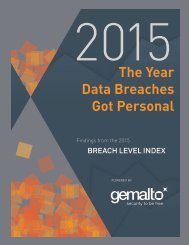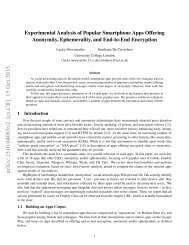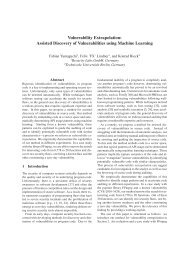Toward Stealthy Malware Detection
Toward Stealthy Malware Detection
Toward Stealthy Malware Detection
Create successful ePaper yourself
Turn your PDF publications into a flip-book with our unique Google optimized e-Paper software.
3.3 Data setsTo test the effectiveness of the n-gram analysis on files, we conductedseveral experiments to determine whether it can correctly classify files andwhether it can detect malcode.The test files used in the experiments include 140 PDF files. Themalicious files used for embedding were collected from emails, internetsources [22] and some target honeypot machines setup for this purpose inour lab. The PDF files were collected from the internet using a generalsearch on Google. In this way, they can be considered randomly chosen asan unbiased sample. These tests are preliminary; considerable more effortis needed to compose a proper set of training and test data to ensure thefiles in question represent a true sample of interest. Here we collecteddocuments from an open source and have no means to accuratelycharacterize whether this sample is truly representative of a collection ofinterest. Nevertheless, this experiment provides some evidence of whetherthe proposed techniques show promise or not.3.4 Detecting malware embedded filesFirst we revisit our malcode embedding experiment. We’ve seen that theCOTS AV system we used can easily miss the malcode hidden insidenormal appearing files. Here we apply the 1-gram analysis and see howwell it may be able to detect the malicious code sequences. 100 of the 140PDF files were used to build head and tail 1-gram models. Then we testedthe remaining 40 normal PDF files and hundreds of malware-embeddedfiles against the model. Since we know ground truth, we measure thedetection rate exactly when the false positive rate is zero, i.e., no normalPDF files been misclassified as malware-infected. The result is displayedin table 3, which is much higher than the COTS anti-virus softwaredetection rate, which for these files is effectively zero. Notice that the totalnumber of malware-embedded files is different for different truncationsizes. That is because the malware used in this study differ in size and weonly consider the problem of classifying a pure malcode block fullyembedded in a portion of the PDF file. We consider a concatenated PDFfile as a test candidate only if the malcode size is equal to or greater thanthe truncation size used for modeling.
Table 3. <strong>Detection</strong> rate using truncated head and tail modelingModels head N bytes1000 bytes 500 bytes 200 bytesDetect49/56(87.5%) 314/347(90.5%) 477/505(94.5%)Models tail N bytes1000 bytes 500 bytes 200 bytesDetect42/56(75%) 278/347(80.1%) 364/505(72.1%)It may be the case that it is easier to detect the malcode if it isconcatenated at the head or tail of a file, since different file types usuallyhave their own standard header information and ending encoding. Malcodemay be significantly different from these standardized encodings.However, we test whether malware can effectively be hidden in somemiddle portion of a file (presuming that the file would still possibly beopened correctly). A reasonable assumption about such insertion is that themalware is inserted as a continuous whole block. So we apply the n-gramdetection method to each block of a file’s binary content and test whetherthe model can distinguish PDF blocks from malware blocks. If so, then wecan detect the malcode hidden inside PDF files.We compute byte distribution models using N consecutive byteblocks from 100 PDF files, then test the blocks of the malware and another40 PDF files against the model, using Mahalanobis distance. Figure 3shows the distance of the malware blocks and PDF blocks to the normalmodel, using N=500 byte blocks and N=1000 byte blocks, respectively. Inthe plot we display the distance of the malcode blocks on the left side ofthe separating line and the normal PDF on the right. As the plots show,there is a large overlap between malcode and PDF blocks. The poor resultsindicate that malware blocks cannot be easily distinguished from normalPDF file blocks using 1-gram distributions.11
Fig. 4. The Mahalanobis distance of the normal PDF and malware blocks to thetrained PDF block model. The left is 500-byte block and the right plot is 1000-byte block.In order to understand why the block-based detection using 1-grams does not work well, we plot the byte distribution of each block of anormal PDF file and the Sasser worm code. The first 9 blocks of the PDFfile and the first 6 blocks of Sasser are displayed in the following plots.These plots clearly show that different blocks inside a PDF file differmuch in their byte distribution, and we cannot determine an absolutedifference of the malcode blocks from PDF blocks. Therefore, it appearsthat a 1-gram statistical content analysis might not have sufficientresolution for malware block detection. Either higher order grams (perhaps2-grams or 3-grams) may suffice, or we may need more syntacticinformation about the file formats to adequately distinguish malcodeembedded in PDF files. A search for better statistical features is part of ourongoing research.
(a) PDF file(b) Slammer wormFig. 5. Byte value distributions of blocks of the PDF file and Sasser worm.3.5 Classifying normal executables and virusesIn this experiment, we use a collection of malcode executables gatheredfrom other external sources, and compare the 1-gram and 2-gramdistributions of these to the corresponding distributions of “normal”Windows executables to determine whether viruses exhibit any clearseparating characteristics. We conjecture that the Windows executables are13
generated by programming environments and compilers that may createstandard “headers” different from those used by virus writers who delivertheir viruses via email or file shares.We apply three modeling methods to these experiments, which areone-centroid, multi-centroids and exemplar files as centroids. The onecentroid method trains one single model for each class (or type) of file. Webuild n models M 1 , M 2 , …, M n , from n different file types. Then, wecompute the distance of the test file F to each model, and F is classified tothe model with the closest distance.Alternatively, the multi-centroids method, we build k models M t 1,M t 2, …, M t k using k-means algorithm for each file type t as described insection 3.2. There are k*T models in total, where T is the number of filetypes. k is set to 10 in this test. The test strategy is the same as in the caseof one centroid. The test file F is classified to the model with the closestdistance.A third method is also tested. Here we use a set of exemplar filesof each type as centroids. Thus, a set of randomly chosen normal files foreach file type are used as centroids. There are N models if there are Nchosen exemplar files. We also analyze the accuracy of the method usingdifferent truncations – first 10, 50, 100, 200, 400, 600, 1000, 2000, 4000,6000, and 8000 bytes, and the entire file. In this experiment, we evaluateboth 1-gram and 2-gram analysis.We trained models on 80% of the randomly selected files of eachgroup (normal and malicious) to build a set of models for each class. Theremaining 20% of the files are used as test files. Again, we know groundtruth and hence can accurately evaluate performance. Note that all of themalicious files extensions are EXE. For each of the test files, we evaluatetheir distance from both the “normal model” and the “malicious model”.31 normal application executable files, 45 spyware, 331 normal executableunder folder System32 and 571 viruses were tested. Three “pairs” ofgroups of files are tested – Normal executable vs. spyware, normalapplication vs. spyware and normal executable vs. viruses. We report theaverage accuracy over 100 trials using cross validation for each of themodeling techniques.The results are shown in figure 6. Each column represents eachmodeling method: one-centroid, muli-centroids and exemplar filecentroids. The rows indicate the testing “pairs”. In each plot, the X and Y-axis are the false positive rate and detection rate, respectively. The asteriskmarks are 1-gram tests using different truncation sizess, and the circlemarks represent the results of 2-gram centoids. In these plots, thetruncation sizes are not arranged in order. In these two dimensional plots,the optimum performance appears closest to the upper left corner of each
plot. That is to say, a false positive rate of 0 and a detection rate of 1 isperfect performance.The results show relatively good performance in some case ofnormal executable vs. spyware and normal executable vs. virus. Becauseviruses and worms usually target the System32 folder, we can reasonablewell detect non-standard malicious files in that folder. Moreover, theperformance results varied under different truncation sizes. Thus, we haveconsiderable additional analysis to perform in our future work to identifyappropriate file sizes (and normalization strategies) to improve detectionperformance. However, the plots clearly indicate that performance varieswidely, which suggests the comparison method is too weak to reliablydetect malicious code.Fig. 6. 2-class classification of malware and normal EXE files. X-Axis: falsepositive, Y-Axis: detection rate. Asterisk marks: 1-gram test, Circle marks: 2-gram test.Notice that there is a high false positive rate in the case of testingnormal applications to the Spyware samples. This is due to two reasons.First, the range of the normal application file size is too large, rangingfrom 10KB to 10MB. It is hard to normalize the models when the dataranges so widely. Second, the spyware files are somewhat similar to15
normal application files. They are both MS Windows applications, andthey may be used for similar purposes. Hence, other features may benecessary to explore ways of better distinguishing this class of files.In the experiments performed to date, there is no strong evidenceto indicate that 2-gram analysis is better than 1-gram analysis. Eventhough the 1-gram memory usage is much smaller and the computationspeed is much faster, we may need to analyze far more many files todetermine whether the heavy price paid in performing 2-gram analysis willperform better ultimately.3.6 Uniform Distributions of 1-gram analysis: encryptedfiles and spywareIn this experiment we scan Windows files to determine whether any areclose to a uniform 1-gram distribution. We thus test whether spyware thatis obfuscated by self-encryption technology may be revealed assubstantially different from other executable files on a Windows hostplatform. We conjecture that self-encrypted files, such as stealthy Trojansand spyware, may be detectable easily via 1-gram analysis.The normal EXE from System32, spyware and virus files used inthe experiments reported in the previous section are used here again.Moreover, we randomly select 600 files (DOC, PPT, GIF, JPG, PDF,DLL) from Google, 100 for each type. Since the models are normalized,the uniform distribution is an array with uniform value 1/n, where n is thelength of the array and n is 256 in the 1-gram test. For each of the test files,we compute the Manhattan distance against the uniform model and plot thedistance in figure 7. The files that are closest to uniform distribution arelisted in table 7.As the plot shows, JPG, GIF and PDF files are self-encoded, sothey are more similar to the uniform distribution. System32 files and DLLfiles are not self-encrypted, and most of the virus and spyware tested arealso not self-encrypted. However, some of the normal files are selfencryptedand quite similar to the random distribution. An interestingexample is the application ad-aware.exe, which is a COTS adwaredetection application that apparently uses self-encryption, perhaps toattempt to protect its intellectual property.
Fig. 7. The distance of testing files against the uniform distribution. X-Axis: thetest files, Y-Axis: the distance.Table 7. Files whose content is deemed close to a uniform 1-gram distribution(hence likely encrypted).File nameIeee-submissioninstruct.docAd-Aware.exemsgfix.exeQazxswcc.exeAsm.exewast2.exeDescriptionAn ieee submission format instruction Word file. It isunclear why this file follows a normal distribution.Ad-Aware.exe: ad-aware from lavasoft, searches andremoves spyware and/or adware programs from yourcomputer.msgfix.exe is the W32.Gaobot.SN Trojan. This Trojanallows attackers to access your computer, stealingpasswords and personal data.qazxswcc.exe is as a backdoor Trojan.asm.exe is a commercial spyware program by Gator. Thisprogram monitors browsing habits and distributes thedata back to a Gator server for analysis. This alsoprompts advertising pop-ups.wast2.exe is an adware based Internet Explorer browserhelper object that delivers targeted ads based on a user’sbrowsing patterns.17
4. Concluding RemarksIn this paper, we demonstrate that simple techniques to embed knownmalcode in normal files can easily bypass signature-based detection. Wesuccessfully inserted known malcode in non-executable (PDF and DOC)files without being detected by AV scanners, and several were normallyopened and executed. Various code obfuscation techniques can also beused by crafty attackers to avoid inspection by signature-based methods.We propose an alternative approach to augment existing signature-basedprotection mechanisms with statistical content analysis techniques. Ratherthan only scanning for signatures, we compute the statistical binary contentof files in order to detect anomalous files or portions of files which mayindicate a malcode embedding. Although it may be relatively easy todetect tainted files where malcode is embedded in the head (where normalmeta-data is expected) or at the tail of a file, detecting embeddings withinthe interior portion of a file poses a significant challenge. The results showthat far more work is needed to identify files tainted by stealthy malcodeembeddings. On the positive side, self-encrypted files are relatively easy tospot.The results reported here are preliminary, and have opened upother avenues of future work. For example, adherence to a 1-gram modelmay not be the right strategy. Higher order grams may reveal morestructure in files, and help identify unusual segments worthy of deeperanalysis. Furthermore, file formats are defined by, typically, proprietaryand unpublished syntactic conventions providing markers delimitingregions of files handled different (eg., embedded objects with specializedmethods for their processing) that may be analyzed by alternative methods.Utilizing this information may provide a finer granularity of modelingnormal file formats and perhaps produce improved performance.Finally, we believe another path may be useful, profiling applicationexecution when opening typical/normal files. It may be possible toidentify portions of files that harbor malcode by finding possible deviationsfrom normal application behavior. Combining static analysis withdynamic program behavior analysis may be the best option for detectingtainted files with embedded stealthy malcode.References:[1] K. G. Anagnostakis, S. Sidiroglou, P. Akritidis, K.Xinidis, E. Markatos, andA. D. Keromytis. “Detecting Targeted Attacks Using Shadow Honeypots”,Proceedings of the 14 th USENIX Security Symposium, 2005.
[2] R. Balzer and N. Goldman, “Mediating Connectors”, Proceedings of the 19IEEE International Conference on Distributed Computing Systems Workshop,1994.[3] M. Christodorescu and S. Jha, “Static Analysis of Executables to DetectMalicious Patterns”, In Proceedings of the 12th USENIX Security Symposium,August 2003[4] M. Damashek. “Gauging similarity with n-grams: language independentcategorization of text.” Science, 267(5199):843--848, 1995[5] E. Eskin, W. Lee and S. J. Stolfo. ``Modeling System Calls for Intrusion<strong>Detection</strong> with Dynamic Window Sizes.'' Proceedings of DISCEX II. June2001.[6] J. Giffin, S. Jha, and B. Miller. “Detecting Manipulated Remote Call Streams”.In the 11 th USENIX Security Symposium, 2002[7] C. Ko, M. Ruschitzka, and K. Levitt. “Execution monitoring of securitycriticalprograms in distributed systems: A specification-based approach”. InProceedings of the IEEE Symposium on Security and Privacy, 1997.[8] J. Kolter and M. Maloof. “Learning to Detect Malicious Executables in theWild.” In the Proceedings of ACM SIGKDD, 2004[9] C. Krugel, W. Robertson, F. Valeur, G. Vigna. “Static Disassembly ofObfuscated Binaries”. In Proceedings of USENIX Security Symposium, 2004.[10] A. Kurchuk and A. Keromytis. “Recursive Sandboxes: Extending Systrace toEmpower Applications”. In Proceeding of the 19 th IFIP InternationalInformation Security Conference (SEC), Aug. 2004[11] W. Li, K. Wang, S. Stolfo and B. Herzog. “Fileprints: identifying file typesby n-gram analysis”. 6 th IEEE Information Assurance Workshop, West Point,NY, June, 2005.[12] M. McDaniel, M. Heydari. “Content Based File Type <strong>Detection</strong> Algorithms”.36 th Annual Hawaii International Conference on System Sciences (HICSS’03).[13] G. Necula, P. Lee. “Proof-Carrying Code” In Proceedings of the 24th ACMSIGPLAN-SIGACT Symposium on Principles of Programming Languages(POPL), 1997[14] F. B. Schneider. “Enforceable security politics”. Technical Report 98-1664,Cornell University, 1998[15] M. Schultz, E. Eskin, and S. Stolfo. “Malicious Email Filter - A UNIX MailFilter that Detects Malicious Windows Executables.” In Proceedings ofUSENIX Annual Technical Conference - FREENIX Track. Boston, MA: June2001.[16] R. Sekar, A. Gupta, J. Frullo, T. Shanbhag, A. Tiwari, H. Yang and S. Zhou.“Specification-Based Anomaly <strong>Detection</strong>: a new approach for detectingnetwork intrusions”, RAID 2002[17] A. Shamir and N. van Someren. “Playing Hide and Seek with stored keys”,Financial Cryptography 1999.[18] D. Wagner and D. Dean. “Intrusion <strong>Detection</strong> via Static Analysis”. In IEEESymposium in Security and Privacy, Oakland, CA, 2001[19] K. Wang, G. Cretu and S. Stolfo. “Anomalous Payload-based Worm<strong>Detection</strong> and Signature Generation”. To appear in Proceedings of the Eighth19
International Symposium on Recent Advances in Intrusion <strong>Detection</strong>, Sept.2005.[20] K. Wang and S. Stolfo. “Anomalous Payload-based Network Intrusion<strong>Detection</strong>”. In Proceedings of the Seventh International Symposium on RecentAdvance in Intrusion <strong>Detection</strong> (RAID), Sept. 2004.[21] C. Warrender, S. Forrest, and B. Pearlmutter. "Detecting intrusions usingSystem calls: alternative data models, Proc. of 1999 IEEE Symposium onSecurity and Privacy, 1999.[22] VX Heavens http://vx.netlux.org/[23] Net Alliance http://www.shellcode.com.ar/docz/bof/pe.pdf









